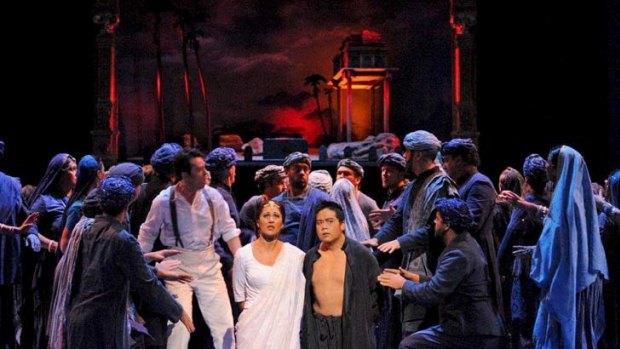By Peter McCallum
THE PEARLFISHERS
Opera Australia
Opera House, July 4
IT IS a shame that, to resolve the love triangle in which he was enmeshed, Zurga had to burn down a whole village. A modern telling of the story of The Pearlfishers would have been satisfied with perhaps a broken window but the romantic orientalist imagination demands a higher price for grand passion.

Shape of things … Nicole Car and Henry Choo, centre, showed auspicious promise in their performance.
Of course, The Pearlfishers is not really about love triangles or oriental villages but about charming and exquisitely memorable melodies, leaving the function of the story ambiguous. It is little more than a mere scaffold to hang the tunes on.
One does genuinely admire Bizet's capacity to persuade us of completely improbable transitions through music: the young lover Nadir's sudden re-infatuation in his aria Je croix entendre encore at the end of Act 1 or the heroine Leila's willingness to break vows of purity after a few minutes of song.
But it is also a little less than something to be taken seriously. Otherwise its patronising racist undercurrents would be completely unacceptable, and it could never have been performed before the late 20th century because the great duet of Act 1, by which the piece is justly well known, would have to be seen as what it is: a declaration of homosexual love, rather than a boys' own adventure-style oath.
In this revival, the charm of the melodies is matched by the charm of young voices. The tenor Henry Choo's voice as Nadir blossomed with colour and honey sweetness as soon as he opened his mouth, and Nicole Car, as Leila, sang with attractive clarity and a brightly hued tone, maintaining admirable pitch precision. Her voice is still young in operatic years, and this performance showed auspicious promise.
As Zurga, Andrew Jones hit his stride in his third-act monologue with a bottle of whisky, injecting expressive drama that galvanised the pitch and tone which previously had been varied. Jud Arthur had reliable firmness as the paternalistic priest Nourabad.
This is a work that relies heavily on choral set pieces, and the Opera and Ballet Chorus swelled and glowed magnificently in places like the close of Act 1. The conductor, Guillaume Tourniaire, was an effective energiser of the score, giving extra intensity to places like the orchestral opening of Act 3 to provide crucial points of musical emphasis.
In other respects, Ann-Margret Pettersson's 2000 production, which sets the whole piece as a flashback by Zurga in old age (still fuelled by whisky) is probably nearing the end of its shelf life. The Hindu gestures in Rosetta Cook's choreography create evocative waves of hand movement but when combined with the gaudy colours of John Conklin's design, there is an effect of a cliched representation of a great culture that aligns a little too closely with Bizet's unthinking orientalism.